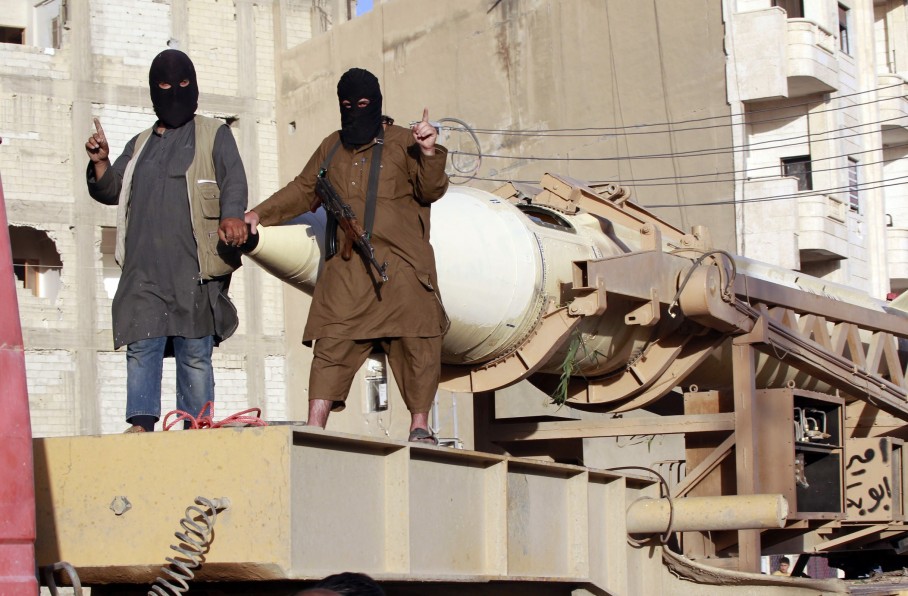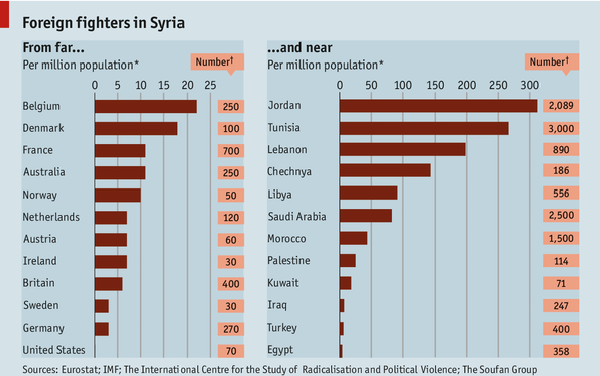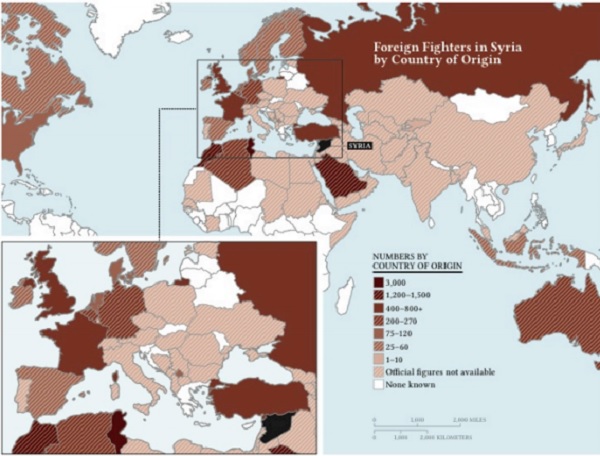At Least 81 Nationalities [of Terrorists] Are Fighting in [against] Syria
SYRIA IN CONTEXT, 1 Sep 2014
Ishaan Tharoor – The Washington Post

Islamic State militants gesture as they take part in a military parade along the streets of Syria’s northern Raqqa province June 30, 2014. (Reuters)
It’s estimated that the three-year conflict in Syria has drawn foreign fighters to its frontlines at a rate faster than any such war in modern memory, including the struggle of the Afghan mujahideen against the Soviet Union in the 1980s. The group that likely boasts the majority of such combatants is the Islamic State, the powerful terrorist organization that now commands a stretch of territory from central Syria to the environs of Iraq’s capital, Baghdad.
The presence of these foreign jihadists has dominated media attention of late. Earlier this week, reports emerged of an American fighter slain in Syria in a battle with another Islamist faction. On Thursday [28 Aug 2014], the White House identified nearly a dozen Americans believed to have joined the conflict in Syria. A British national is suspected to have beheaded American journalist James Foley this month, while a pair of Australians have gained notoriety for their habit of posting selfies on social media of them grinning while clutching the severed heads of Assad regime soldiers.
The Soufan Group, a New York-based intelligence firm, estimated in June that there were at least 12,000 foreign fighters from 81 countries in the Syrian conflict, including some 3,000 European nationals. Given the Islamic State’s ascendance — and its slick online recruitment operation — it’s probable that the bulk of the Western militants are in its ranks. The Economist published a handy graphic of the breakdown this week:
The total numbers are probably higher. The New York Times reported Friday that more than 100 Americans have participated in the conflict in Syria, according to U.S. intelligence officials. The Independent, meanwhile, says that a quarter of the roughly 2,000 European fighters in the Islamic State are British.
For months now, European governments have wrung their hands over the consequence of this migration and the threat of radicalized fighters returning home, spreading their extremism and plotting terror attacks. The Islamic State’s brutal murder of Foley was a sign that the West is in its crosshairs, even as it wages battles on multiple fronts against rival militias and governments in Iraq and Syria. On Friday, British Prime Minister David Cameron sounded the alarm, warning that the fight against the Islamic State’s militancy would take “years and probably decades.”
As the map above shows, the geographical spread of foreign fighters in the war is vast, implicating even Japan and Singapore, countries most would think are alien to the turmoil of the Middle East. Islamic State recruitment videos have been translated into myriad languages, including Urdu, Tamil, and Bahasa Indonesia. There are more Muslims in South and Southeast Asia than the Arab world.
Still, the majority of foreign fighters in the conflict, as the Economist’s chart shows, are from Arab countries. A deep dive into the workings of the Islamic State by the Times shows that the organization relies on local support, largely drawn from Sunnis who are embittered by the Shiite-dominated regimes around them. Loyalists from the defunct Ba’ath Party of Iraq’s toppled dictator Saddam Hussein — an institution that was nominally secular — are thought to be enmeshed within the Islamic State’s current command structure in Iraq.
At the same time, the Islamic State continues its hideous butchery of captured soldiers and religious and ethnic minorities now trapped in its de facto domain. That foreigners are playing an outsize role in its most barbaric acts ought be a chilling sign for world leaders elsewhere, struggling for a strategy to counter this growing threat.
________________________________
Ishaan Tharoor writes about foreign affairs for The Washington Post. He previously was a senior editor at TIME, based first in Hong Kong and later in New York.
Go to Original – washingtonpost.com
DISCLAIMER: The statements, views and opinions expressed in pieces republished here are solely those of the authors and do not necessarily represent those of TMS. In accordance with title 17 U.S.C. section 107, this material is distributed without profit to those who have expressed a prior interest in receiving the included information for research and educational purposes. TMS has no affiliation whatsoever with the originator of this article nor is TMS endorsed or sponsored by the originator. “GO TO ORIGINAL” links are provided as a convenience to our readers and allow for verification of authenticity. However, as originating pages are often updated by their originating host sites, the versions posted may not match the versions our readers view when clicking the “GO TO ORIGINAL” links. This site contains copyrighted material the use of which has not always been specifically authorized by the copyright owner. We are making such material available in our efforts to advance understanding of environmental, political, human rights, economic, democracy, scientific, and social justice issues, etc. We believe this constitutes a ‘fair use’ of any such copyrighted material as provided for in section 107 of the US Copyright Law. In accordance with Title 17 U.S.C. Section 107, the material on this site is distributed without profit to those who have expressed a prior interest in receiving the included information for research and educational purposes. For more information go to: http://www.law.cornell.edu/uscode/17/107.shtml. If you wish to use copyrighted material from this site for purposes of your own that go beyond ‘fair use’, you must obtain permission from the copyright owner.

